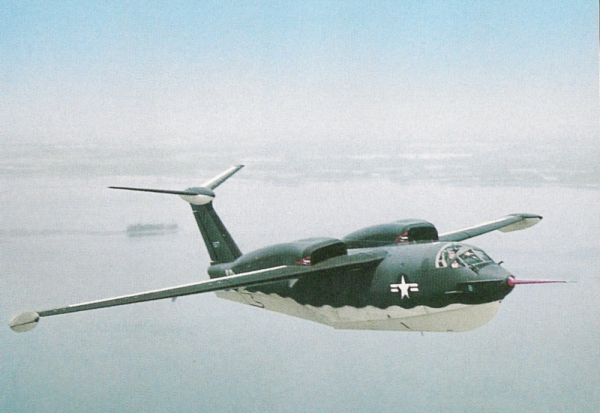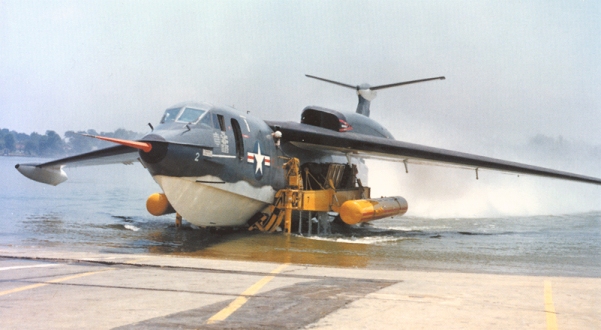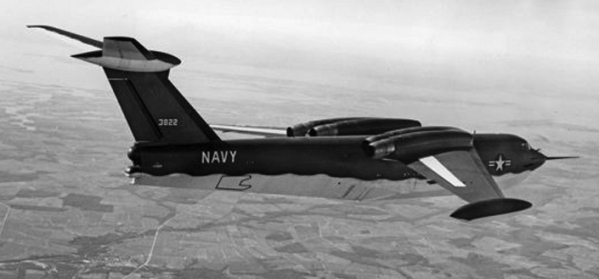
|
 |
Martin P6M Seamaster |
 |
 |
 |
 |
 |
|---|---|---|---|---|---|---|---|
 |
 |
 |
 |
 |
|||
 |
||
|
After the USS United States supercarrier was killed by the Pentagon in the early days of the Cold war in favor of the Air Force’s B-36 bomber, the US Navy came up with a plan for a force of nuclear-armed seaplanes in order to get a piece of the strategic pie. The Seaplane Striking Force would comprise of jet-powered flying boats capable of long-range strategic nuclear attack as well as conventional bombing, mine-laying, and reconnaissance. Only two companies submitted proposals and the Martin P6M Seamaster was chosen over the Convair prototype. In 1952, Martin was awarded a contract for a design study and a production contract for two prototypes known as the Model 275.
The Seamaster was effectively a seagoing B-52 and would operate in small numbers and be refueled and rearmed by submarines or other small naval craft. The first of two prototypes, the XP6M-1 made its first test flight on July 14, 1955 and were powered by four Allison J71-A-4 turbojet engines mounted in two nacelles on top of the fuselage near the wing roots. The 40 degree swept-wings had a distinct anhedral that drooped, allowing the wingtip tanks to sit on the water and serve as stabilizing floats. Testing was conducted in secret on the Chesapeake Bay and results were promising, but it was revealed that the jet exhausts were too far inboard and scorched the fuselage when the afterburners were used. The airplane was revealed to the public in November 1955, but on December 7, 1955, the horizontal stabilizer malfunctioned, causing the first prototype to break up in flight, killing all four crew members. The horizontal stabilizer ran to full travel causing the aircraft to pitch down sharply. The engines tore away from the wings, which, under the high airloads, bent down and actually touched beneath the hull, before the aircraft broke up. Test flights of the second prototype continued in May 1956, but during special vibration checks, the aircraft went out of control and executed a tight loop before breaking up. However, the crew managed to escape through a tube like hatch just aft of the flight deck. |
| Testing continued with the YP6M-1 pre-production model and the nacelles were angled five degrees from the fuselage to prevent scorching. During flight testing, the airplane achieved Mach 0.9 which was even faster than the B-52. It embodied all the design features developed during World War II and immediately after the war. The P6M would be modern in almost every way, despite their untimely destruction during tests. |
|
The production Martin P6M-2 Seamaster had four-man crew and a gross take-off weight of 160,000 lb (72,575 kg), the same as the Convair Tradewind. The technology involved in its design was the latest known and included four Pratt & Whitney J75-P-2 turbojet engines of 17,500 lbs (7,938 kgs) thrust, without afterburners. There was also an aerial refueling probe, a rotating watertight bomb bay, Sperry navigation, flight control and autopilot systems, a high-visibility canopy, and a probe-and-drogue kit for conversion to a tanker. The added weight of the modifications made the P6M-2 ride lower in the water, eliminating the need for the wing anhedral.

It had a T tail configuration and a high length-to-beam ratio of its 134 ft (40.84 m) hull. The engines were mounted in such a way as to prevent ingestion of the water spray pattern into the engine air-intake ducts. Also incorporated in the design of the P6Ms was a watertight rotary bomb bay. This could be flipped over in flight to expose the bomb racks which could be loaded on the inside of the hull with bombs, mines, cameras or other ordinance stores.

The engines were mounted to prevent ingestion of the water spray pattern into the engine air-intake ducts. The wing-tip floats were integral parts of the drooped wing configuration. The Navy had ordered an initial fleet of 24 Sea Masters, but through delays caused by the redesign work and an accompanying steep rise in costs, the order was reduced to eighteen. The Navy boasted how well their new aircraft could mine the Black Sea, and claimed it was "a major new anti-submarine warfare system . . . able to go after enemy submarines in their home ports." However, by this time the force of 18 aircraft had been reduced to eight, which were planned to operate as a single squadron from a new 'seadrome'. In the event, even these eight aircraft proved too expensive and only an additional three production P6M-2s Sea Masters were built.

The Seamaster supplanted by the Polaris submarine-launched ballistic missile and the program was discontinued in the autumn of 1959. Martin tried to modify the SeaMaster concept into an eight-engine civilian airliner called the SeaMistress, and also toyed with the notion of a nuclear-powered flying boat and a supersonic seaplane, but the idea would go nowhere. The SeaMasters were scrapped except for two tails, a fuselage section, and wing floats, which now reside in the Glenn L. Martin Aviation Museum in Baltimore, and four wingtip floats a Martin employee scrounged to build a catamaran. Martin gave up building aircraft entirely to concentrate on military electronics and missiles and the P6M was the final aircraft constructed by the Glenn L. Martin Company.

|
| Specifications: | |
|---|---|
| Martin P6M Seamaster | |
| Dimensions: | |
| Wing span: | 100 ft 0 in (30.48 m) |
| Length: | 134 ft 0 in (40.84 m) |
| Height: | 31 ft 0 in (9.45 m) |
| Weights: | |
| Payload: | 30,000 lb (13,608 kg) |
| Max T/O: | 160,000 lb (72,575 kg) |
| Performance: | |
| Maximum Speed: | 600 mph (965 km/h) |
| Service Ceiling: | 40,000 ft (12,200 m) |
| Range: | 3,000 miles (4,830 km) |
| Powerplant: | |
| Four Pratt & Whitney J75-P-2 turbojets providing 17,500 lb (7,938 kg) st. | |
| Armament: | |
|
Six or eight .050 machine guns in the nose and amidships turrets plus, up to 4,000 lbs (1,814 kg) of bombs or depth charges. | |
© The Aviation History On-Line Museum.
All rights reserved.
Created April 12, 1997. Updated November 2, 2013.